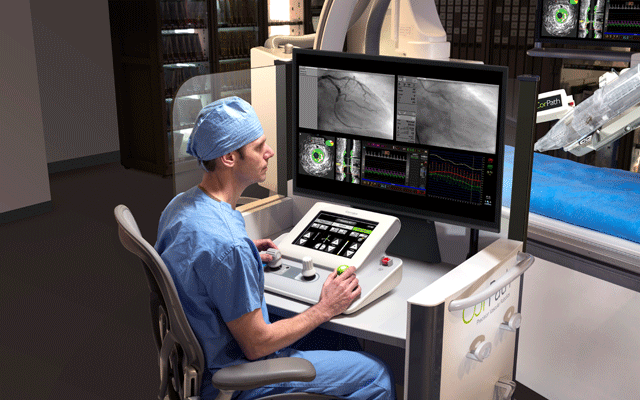
Corindus Vascular Robotics has announced that Ryan Madder (Spectrum Health, Ludington, USA) has successfully completed a remote percutaneous coronary intervention (PCI) in a porcine model using the CorPath GRX system from a location greater than 100 miles from the catheterisation lab.
Working from a Spectrum Health facility in Ludington, according to a press release, Madder leveraged the CorPath GRX system to remotely manipulate interventional devices through the subject’s coronary arteries while using a telecommunications system to communicate with the bedside staff based in Grand Rapids, USA.
Madder has been exploring the feasibility of remote PCI since 2016 when he completed and published the REMOTE-PCI study. In that study, he and his colleagues completed multiple robotic stent procedures from an isolated room outside the procedure room. Procedural success was achieved in 19 of 20 patients (95%). He says: “The REMOTE-PCI study previously demonstrated that remote PCI is feasible. Our recent case completed over a distance of greater than 100-miles now demonstrates that remote robotic PCI can be successfully performed in vivo by a physician who is located at great distances away from the PCI recipient. This achievement is a significant milestone toward breaking down the geographic barriers that prevent many patients in remote regions of the world from undergoing coronary stenting.”
The press release notes that the global shortage of PCI-capable operators is significant and continues to be a growing problem. Remote PCI has the potential to enable physicians to conduct procedures from virtually any location, opening opportunities for more patients globally to receive the benefits of this lifesaving procedure.
Mark Toland, president and CEO of Corindus, states: “We have made considerable progress in the realisation of remote PCI capabilities through work with our clinical partner at Spectrum Health. Dr Madder’s 100-mile case simply exceeds our expectations. His achievement allows our customers and partners to envision the possibilities of remote treatment and validates our broader vision of striving to apply remote technology to treat other vascular diseases such as acute ischaemic stroke.”













